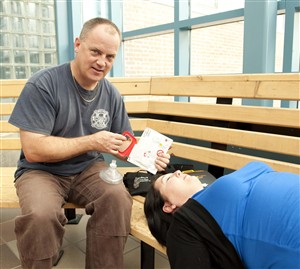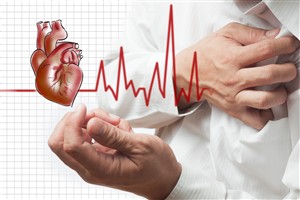10/18/2013 1:43:55 PM

The Heart and Stroke Foundation of Newfoundland and Labrador, through funding provided by the Boston Pizza Foundation, donated 17 Automatic External Defibrillators (AED) to College of the North Atlantic and trained eight employees at each campus in their use. An AED, together with CPR techniques, can increase the chance of survival for someone in sudden cardiac arrest by up to 75 per cent. Rick Wheeler, Electronics Engineering instructor at Corner Brook campus, shows how to use the AED.

Standing in line, playing softball or even sitting on your sofa at home – sudden cardiac arrest could strike at any time. Age isn’t a factor and there’s no warning before you become unconscious, stop breathing and your heart stops beating. Clinically, you’re dead with a very narrow window to get treatment.
Every 12 minutes someone in this country goes into sudden cardiac arrest. However, the use of an Automatic External Defibrillator (AED) together with CPR techniques can increase the chance of survival to up to 75 per cent. To help beat the odds and save more lives, AEDs have been placed at every campus of CNA.
The Heart and Stroke Foundation of Canada’s AED program is committed to increasing the number of AEDs in communities across Canada. The program focuses on increasing public awareness on the role of AEDs and encourages citizens to make a difference by learning CPR so they are able to respond to a sudden cardiac arrest emergency.
The Heart and Stroke Foundation of Newfoundland, through funding provided by the Boston Pizza Foundation, donated 17 AEDs to College of the North Atlantic (CNA) and trained eight employees at each campus in their use. According to Primary Care Paramedicine instructor Nolan Baggett, it’s important to have AEDs readily available in case of an emergency.
“Most people would think an AED would most benefit the elderly and those who live a lifestyle that increases their chances of heart disease,” Nolan says. “However, anyone over the age of 35 to 40 is the norm now. There are also other reasons why the heart would stop and an AED would be very helpful in saving their life.”
He says a typical example is a young person with an undiagnosed abnormal heart condition who receives a blunt, non-penetrating blow to the chest. This could happen in a sport such as baseball or hockey. In addition to the students and employees walking the halls each day, the college regularly has other visitors who could be in need of an AED device.
“Students play sports and other physical activities. Parents, grandparents and other family members visit the campuses. Special events, such as alumni fundraisers, corporate donor recognition, blood donor clinics, and skills competitions bring large numbers of people to the campuses.”
With large numbers of people at the campuses each day it’s better to be prepared in case of an emergency, as the national survival rate from sudden cardiac arrest outside a hospital is approximately five per cent.
“Time is critically important,” Nolan says. “The likelihood that a person will survive cardiac arrest involving an abnormal heart rhythm that can be treated by the AED decreases seven to 10 per cent with every minute that use of the AED is delayed. That’s why the AED’s are placed in high traffic areas, such as a main lobby.”
Rick Wheeler is an Electronics Engineering instructor at Corner Brook campus. In addition to his duties with CNA, Rick has spent 18 years with Pasadena Fire and Rescue and is a certified AED instructor for the Heart and Stroke Foundation. As a certified first responder to the scene of an emergency, he says it’s important to have the AEDs readily available.
“With up to 1,000 people in this building (Corner Brook) it is crucial that in the event of cardiac arrest, CPR and use of an AED is performed within five minutes. An ambulance could take up to 10-15 minutes to get here so you’re past the critical point of survival for a person.”
Heart and Stroke Foundation CEO, Mary Ann Butt says the placement of AEDs at campuses across Newfoundland and Labrador makes for a safer environment for everyone.
“Thanks to outstanding support from the Boston Pizza Foundation, the placement of these 17 AEDs has made CNA campuses a safer environment for students, staff and all who use the facilities,” she says. “We commend CNA's leadership for recognizing the importance of access to AEDs, effective, simple-to-use devices that anyone can use to save a life. The Heart and Stroke Foundation is strongly committed to our AED program that will see a further 13 of these devices placed across the province in 2013 in our efforts to improve survival rates for out-of-hospital cardiac arrests.”
“Knowing how to respond, and having an AED as part of that response can increase the odds of survival substantially,” adds Nolan. “We are pleased to partner with corporate donors such as the Heart and Stroke Foundation and the Boston Pizza Foundation to help save the life of everyone who comes through the college’s doors.”
-30-
Media Contact:
Glenda McCarthy
Public Relations Specialist
College of the North Atlantic
709.643.6408
glenda.mccarthy@cna.nl.ca